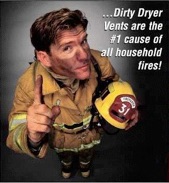Fire prevention



One of the most common causes of dryer fires is lack of
maintenance.
When lint traps aren’t cleaned as often as
they should be, the resulting build-up in the
screen or other areas can cause the dryer to perform
poorly, operate at elevated temperatures and possibly
overheat with dangerous consequences.
Vent systems must also be checked and cleaned to
maintain proper air flow for the same reasons.
A full load of wet clothes placed in dryer contains about
one half gallon of water. As water is removed, lint is created from the clothes.
Clothes dryers are one of the most expensive appliances in your home to operate. The
longer it runs, the more money it costs you.
Facts and figures
- In 2010, en estimated 16,800 reported U.S. non-confined or confined home structure
fires involving clothes dryers or washing machines resulted in 51 civilian deaths, 380 civilian injuries and $236 million in direct property damage.
- Clothes dryers accounted for 92% of the fires; washing machines 4% and washer and dryer combinations accounted for 4%.
-
-The leading cause of home clothes dryer and washer fires was failure to clean (32%) followed by unclassified mechanical failure or malfunction (22%). Eight percent were caused by some type of electrical failure or malfunction.
-
-There are no comparable statistics available for Canada.
Installation of duct to the code
-
-Code typically require that the dryer duct be no more then 25 feet in length. It should be 2.5 feet shorter then 25 feet for every 45-degree and 5 feet shorter for every 90-degree bend. If the duct is longer then 25 feet in length, the system requires a booster fan or high-output dryer.
-
-Duct should be smooth metal with a minimum diameter of 4 inches, in some cases should be insulated. Flexible duct should not be used, since they collect more lint and can easily be crashed and potentially start lint fires. The duct should not have screws or connectors, which can collect lint, blocking flow of combustion gases. Backdrafting can occur if the ducts are blocked, sending harmful carbon monoxide back in to the home.
-
- The male ends of the duct should face the direction of the air flow. The duct exhaust must not mix with or pass through other systems, such as return-air plenum, because heat, moisture and combustion gases could mix the conditioned air in the home.
-
- The dryer exhaust duct should vent to the outside, and the vent should be at least three feet from any other opening. the vent should also have a termination cap and dumper to keep vermin out of the home. There should not be a screen over the opening, since it could trap lint and cause a fire.
-
- Transition duct is a flexible connector used as a transition between dryer outlet and the connection point to the exhaust duct system. Transition duct should be metal like (foil) fabric supported on a spiral wire frame. Transition duct connectors are limited to 8 feet in length and they must remain entirely within the room in which the appliance is installed.
T: 250-729-5634

